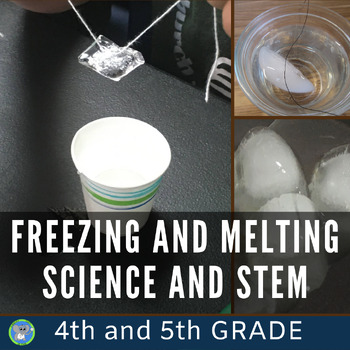Properties Of Water Science and STEM | Dangling Ice Experiment | Grade 4 5
- PDF
- Easel Activity
Also included in
- Explore freezing and melting points by taking this classic experiment up a notch with an ice fishing STEM Challenge. This multi-grade bundle includes an experiment, further exploration activity, reading passages, and a STEM challenge. It is great for a science lab teacher or a homeschool with multipPrice $14.24Original Price $17.80Save $3.56
Description
Discover water's freezing point and the salt's effect on ice with a complete project-based unit. Uses inexpensive and easy-to-find supplies. This engaging unit includes an experiment, reading passages, further exploration, and STEM Challenge. Great for the winter and Christmas season.
Included in the Hands-On Investigation and Teacher Guide:
- 5th Grade Structure and Properties of Matter NGSS Alignment
- 3-5 NGSS Science and Engineering Practices Alignment
- Background Information and Tips
- 3 Hands-on Activities
- 6-Page Dangling Ice Investigation Journal at the student’s level
- Further Exploration with different materials and a CER Prompt
- Ice Fishing Game STEM Challenge
- "The Science of Salt and Ice" Reading Passage
- "How does Salt Make Ice Cream?" Reading Passage
- Rubric and Answer Keys
- Link to a video tutorial with more tips.
- Terms of Use
Students will complete 3 activities. First, they follow the scientific method to investigate if the amount of salt will affect the duration a piece of string can hold up an ice cube. The word duration is introduced. Reading passages are included to enhance the unit. Students explore further by testing other materials. Students participate in an engaging STEM challenge by creating an ice fishing game. Language arts is integrated with students writing the rules and steps for the game.
By the end of this unit, the students should understand that melting requires heat, heat energy transfers, and the freezing point of water can be changed with salt.
Teachers will like to include this in their properties of matter and thermodynamics unit. They will enjoy the clear variables and alignment with the standards. Watching students' excitement as they lift the ice cube is always enjoyable. There is flexibility to modify and integrate your teaching methods.
Follow exactly, and you have 2 weeks of lessons done. As a science lab teacher, it takes me about 6 classes, meeting once a week with help from the regular teacher.
Supplies needed:
cups, ice cubes, salt, string, water, timer, variety of strings, pie pans or plates, and basic STEM building supplies for fishing poles and ponds (Supplies can be modified. Just test first.)
This investigation is part of a series. This is the 4th/5th-grade version. Please click each grade level version below to see more details. We hope your students have a wonderful experience discovering solid and liquid water.
Freezing And Melting Ice Science And STEM | Winter Activity | Grade K 1
Freezing And Melting Points Ice Science And STEM | Winter Activity | Grade 2 3
Get the Bundle and SAVE 20%
Winter Science | Freezing And Melting Ice Science and STEM | A Grade K-5 Bundle
Great for the classroom, science fairs, STEM Fairs, science clubs, scout groups, center time, homeschoolers, and anyone wanting to discover salt on ice.
We prefer printing the journal, but digital versions can be helpful. The unit is a PDF but comes with a pre-created Easel by TpT overlay. We added text boxes and tips for completing it online. Click "Open in Easel" on the product page to get started.
You may also like
Properties of Matter: The Spinning Egg Test
Inertia and Gravity: Investigate the Laws of Motion
Remember, leaving feedback earns you points toward FREE TPT purchases. We love hearing how the investigation went.
Also, follow us and be notified when new explorations are uploaded and deals.
Please contact us with any questions. We are here to help.
Yours in Science,
Kimberly Scott
All parts are copyrighted. Please see the terms of use in the download. Please use good lab practices. The seller is not responsible for the use or misuse of the activities.







